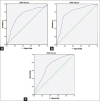Diagnostic accuracy of indigenously developed computer-based binocular vision assessment
- PMID: 35937733
- PMCID: PMC9351962
- DOI: 10.4103/ojo.ojo_460_20
Diagnostic accuracy of indigenously developed computer-based binocular vision assessment
Abstract
Context: The increased prevalence of nonstrabismic binocular vision anomalies (NSBVA) has given rise to the need for cost-effective screening and diagnostic tools.
Aims: The aim of the study is to assess the efficacy of an indigenously developed computer-based binocular vision assessment software (Train Your Eyes®) in screening NSBVA.
Subjects and methods: Subjects who visited the binocular vision clinic of a tertiary eye care center with asthenopic symptoms between January 2019 and January 2020 were included in the study. Patients with other ocular comorbidities and stereopsis poorer than 500 arc seconds were excluded. All subjects underwent a comprehensive eye examination followed by binocular vision assessment using both the manual and computer-based methods.
Statistical analysis used: Receiver operating characteristic (ROC) curves were utilized to choose the cut-off points that maximize the sensitivity and specificity.
Results: The mean (standard deviation) age of 88 subjects was 22 (4.5) years with 34 males. Based on the conventional manual assessment, 71 (81%) were diagnosed to have NSBVA and 17 (19%) had normal binocular vision. Based on the ROC analysis, the following cut-off points are proposed: 14 prism diopter (PD) for near positive fusional vergence amplitudes, 4.5 PD for near negative fusional vergence amplitudes, 4.5 cycles per minute (cpm) for binocular accommodative facility, and 3.5 cpm for monocular accommodative facility. All the binocular vision parameters demonstrated statistical significance in the ROC analysis (P < 0.05).
Conclusions: The software-based screening tool was found to be highly sensitive in identifying NSBVA and thus could be used as a potential screening tool in the clinic and community.
Keywords: Nonstrabismic binocular vision anomalies; random-dot stereogram; train your eyes.
Copyright: © 2022 Oman Ophthalmic Society.
Conflict of interest statement
There are no conflicts of interest.
Figures



References
-
- Scheiman M, Gallaway M, Coulter R, Reinstein F, Ciner E, Herzberg C, et al. Prevalence of vision and ocular disease conditions in a clinical pediatric population. J Am Optom Assoc. 1996;67:193–202. - PubMed
-
- Rouse MW, Hyman L, Hussein M, Solan H. Frequency of convergence insufficiency in optometry clinic settings. Convergence insufficiency and reading study (CIRS) group. Optom Vis Sci. 1998;75:88–96. - PubMed
-
- Hussaindeen JR, Rakshit A, Singh NK, George R, Swaminathan M, Kapur S, et al. Prevalence of non-strabismic anomalies of binocular vision in Tamil Nadu: Report 2 of BAND study. Clin Exp Optom. 2017;100:642–8. - PubMed
-
- Hussaindeen JR, Rakshit A, Singh NK, Swaminathan M, George R, Kapur S, et al. The minimum test battery to screen for binocular vision anomalies: Report 3 of the BAND study. Clin Exp Optom. 2018;101:281–7. - PubMed
-
- Chen AH, Iqbal R. The effect of refractive error and race on the vergence and accommodation systems. ACBO Behav Optom J. 2000;8:5–8.
LinkOut - more resources
Full Text Sources
